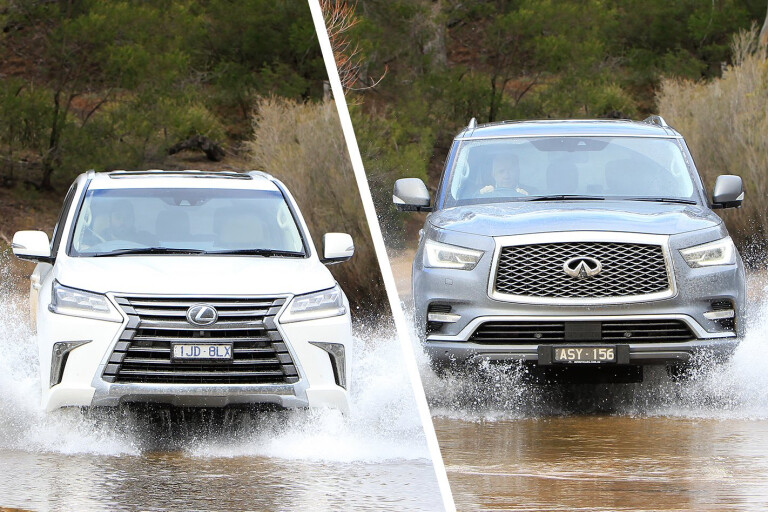
TODAY’S luxury 4WD market is dominated by diesel-powered wagons, but you’re still in luck if you want the outright grunt and aural qualities supplied by a V8 petrol engine, as well as genuine off-road capability.
These vehicles are based on large 4WD wagons from their respective parent companies – Toyota’s Land Cruiser 200 and Nissan’s Patrol – but with oodles more bling and tech thrown in. For buyers wary of the complexity of new-tech diesel engines, the more straightforward engineering of a naturally aspirated engine will appeal, as does the more direct performance response both on- and off-road. They sound awesome, too.
PRICE AND EQUIPMENT
THE Infiniti QX80, at $110,900, is very well priced for a luxury 4WD wagon, while the Lexus LX570 asks a fair chunk more change, at $142,789. The Infiniti QX80 is powered by Nissan’s high-tech 298kW/560Nm 5.6-litre V8, backed by a seven-speed automatic gearbox; the Lexus LX570 makes do with a slightly less grunty 270kW/530Nm V8, but it gains an additional ratio with its eight-speed auto.
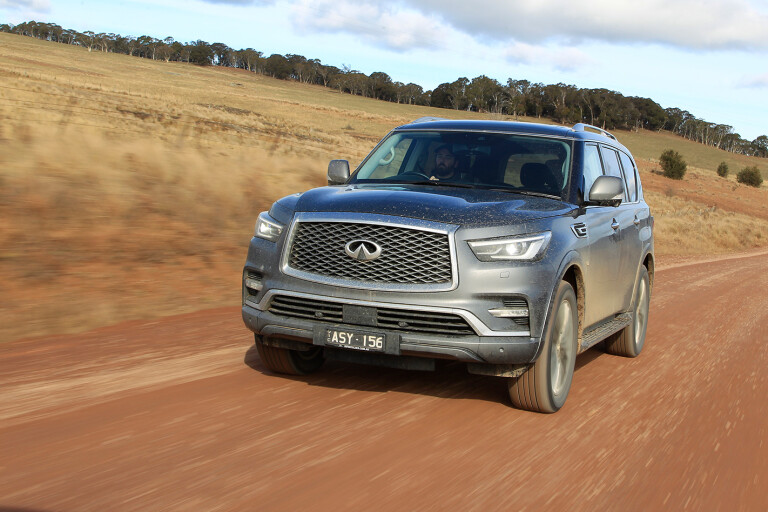
As tested, the Lexus included additional accessories, with the Enhancement Pack ($16,500 for 21-inch alloy wheels, heated steering wheel, front seat and second row seat ventilation and second row seat heating) and Premium paint (Sonic quartz, at $1500) lifting the overall price to $160,789.
Both vehicles are packed with an extensive list of safety features. The QX80 includes ABS, BA (Brake Assist), HDC (Hill Descent Control), EBD (Electronic Brakeforce Distribution), VDC (Vehicle Dynamic Control) incorporated into the TCS (Traction Control System), as well as more modern safety tech such as BCI (Backup Collision Intervention), DCA (Distance Control Assist) and PFCW (Predictive Forward Collision Warning). DCA works in conjunction with IBA (Intelligent Brake Assist) to warn the driver of a possible front collision and, if the driver does not respond, it automatically applies the brakes. Add in BSW (Blind Spot Warning), intelligent parking system with BSI (Blind Spot Intervention) and a tyre pressure monitor system.

The Lexus LX570 offers an equivalent list of acronyms denoting the same high levels of safety tech, with ABS, BA, HDC and EBD all included, as well as VSC (Vehicle Stability Control). An additional piece of welcome safety tech is RCTA (Rear Cross Traffic Alert), which works in conjunction with the vehicle’s BSM (Blind Spot Monitor). This uses what Lexus describes as “quasi-millimetre wave radar” to detect vehicles approaching from the side of you, i.e. when you’re reversing out of a parking space and cannot see approaching traffic. There’s also the Wide View Front and Side Monitor system that offers vision from grille- and passenger side mirror-mounted cameras for when off-roading, to ensure ample vision for the driver.
WINNER: Infiniti QX80
INTERIOR AND CONNECTIVITY
THESE are premium luxury vehicles and their respective well-finished interiors reflect this. The LX570’s all-leather seating is subtle in style but big on support, with the pronounced side-bolstering very effective. Leather also covers the dash, door panels and arm rests. The QX80’s ‘quilted’ leather seats are more garish and fussy in style, and they’re also firmer, quite flat and lack supportive side sections, which leads to unwelcome sliding around during cornering.
There is excellent outward vision from both when driving, with the QX80’s larger glass areas giving it a slight edge here; the revised bonnet for this latest incarnation is taller and more bulbous than the previous-gen, inhibiting close-quarter vision. The LX570’s bonnet is no smaller and just as hard to see over. On-road this isn’t a huge deal, but off-road it is.

The steering wheel on both vehicles is reach/tilt power adjust, allowing for that ideal position. The dash and console area in each is wide, with the QX80 winning the faux-chrome award but also winning the ease-of-use gong; all switchgear is close to hand, as are the controls for air-con, heating and the sound system. The LX570 relies on a ‘remote touch interface’, which is basically a computer-mouse-like controller that sits flat on the dash and is operated by an overly sensitive toggle handle, to operate the massive 12.3-inch multimedia screen and also to select drive modes. Other than that, everything else is easy to use, with the various control switches lit up with backlights for excellent legibility. There’s also the bonus of an inbuilt cooler in the centre console.
They’re both massive, but the QX80 is the larger and longer (5340mm versus 5080mm), and its spacious interior reflects this. Three burly blokes can sit beside each other in the second row quite comfortably, with ample head and shoulder room. The QX80’s power-operated third-row seats are stored in the floor of the cargo area but are relatively easy to access and pleasant to spend time in; although, it’s for two adults only, or three little ones. Impressively, even with the third row up there’s still usable cargo space behind it; with the third row down you’ll never fill the voluminous rear cargo area.
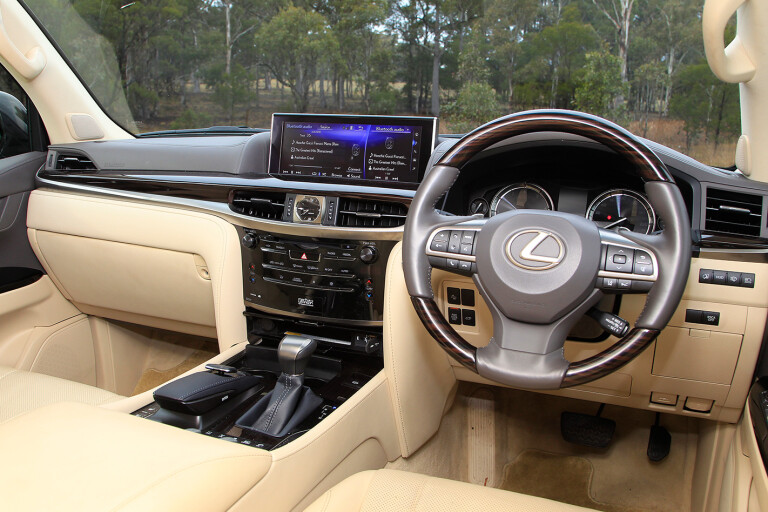
The LX570 is still spacious, just not as much in this company; three adults will find the second-row seating noticeably tighter in width. The third-row seats (a combo of power-operated and manual) are smaller, less comfortable and access is more awkward, with less legroom than the QX80. Plus, the seats eat up valuable cargo space as they fold up vertically to the side of the vehicle’s cargo area, rather than into the floor.
Thanks to its 11.6-inch high-definition screens affixed to the back of each front seat – and the ease of connectivity (HDMI, volume controls, and headphone and phone ports located in the rear of the centre console) – the LX570 keeps passengers entertained. The QX80 sticks with eight-inch in-seat screens, with connectivity via a HDMI auxiliary port and USB port at the rear of the centre console (there’s also aux-in audio jacks for headphones). Besides this, each vehicle has a plethora of USB ports dotted around the cabins.
The LX570’s sound system is a Mark Levinson Reference Surround Sound system, with 19 speakers and 16-channel, 450W output DSP amps, with the speaker system a three-way setup. The QX80’s InTouch infotainment system is easier to use and is not short on aural grunt thanks to its 15-speaker Bose Cabin Surround sound system.
WINNER: Lexus LX570
ON-ROAD RIDE AND HANDLING
FOR wide, tall and very heavy wagons – the QX80 weighs 2660kg; the LX570 2740kg – both offer surprisingly decent on-road ride and handling. The Infiniti runs on massive 22-inch alloy wheels shod with Bridgestone Dueler H/T 275/50R22 tyres, while the LX570 has 21-inch alloys wrapped in Dunlop GrandTrek PT3A 275/50R21 rubber. Both vehicles carry full-size spares.
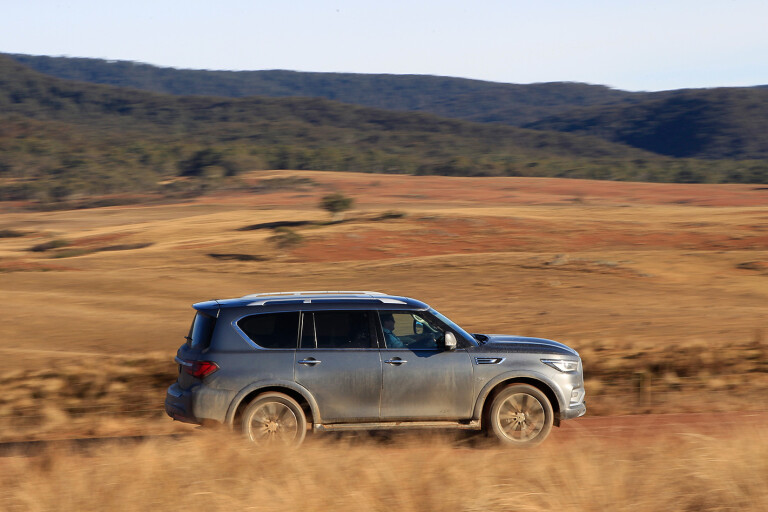
The QX80 sits atop a traditional separate steel chassis and features all-independent suspension that includes Nissan/Infiniti’s trick Hydraulic Body Motion Control (HBMC). The LX570, also a separate-chassis vehicle, offers an independent front end but uses a five-link solid beam axle setup for the rear, with Adaptive Variable Suspension (AVS) and an all-hydraulic Active Height Control (AHC) system instead of coil springs.
The QX80 drives through an on-demand 4WD system that defaults to rear-wheel drive, but it can apportion power to the front wheels if a loss of traction at the rear is detected. On-road, the big Infiniti resembles an oversized go-kart with its sharp, direct handling, going against all the laws of physics as it delivers a flat-cornering, responsive and enjoyable on-road experience. This is due to the HBMC that, put simply, replaces shock absorbers with four interlinked hydraulic rams. As the vehicle leans, hydraulic fluid pumps to the other side of the vehicle to retain a flat cornering stance, and it works exceptionally well. Combine this with sharp, light steering and this huge vehicle does a good job of impersonating something far smaller and more nimble, albeit with noticeable road vibration coming through the steering and chassis.
In terms of outright performance, the Infiniti V8 is a stonker; planting the foot is accompanied by a low growl that builds along with rapid speed. Impressively, the QX80 brakes are well up to the task of stopping the behemoth.
The LX570 is not as sporty in its handling; there is more body roll and the steering, while speed-sensitive, is more heavily weighted. The live-axle rear also causes the vehicle to move around a bit more on-road, requiring noticeable arm-work to keep it in line. The ride itself, though, is noticeably smoother than the QX80, and you can tweak the throttle response, steering response, and how the transmission reacts via its Drive Mode Select system. There are five modes – Normal, Eco, Comfort, Sport S and Sport S+ – in this system, all of which change how the vehicle performs. For optimum performance there’s also a Customise feature (available in on-road and off-road), which allows further tweaking by the driver. It’s a bit fiddly to access the menu, but is time well spent to extract the best performance.
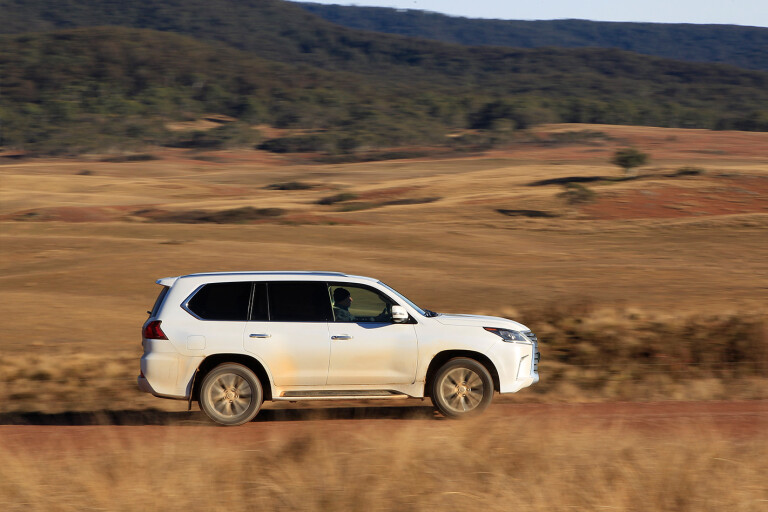
The LX570 engine is a bit lazier in its delivery of performance, but the eight-speed gearbox is very smooth in operation; plus, you’re far more removed from road noise inside the cabin. The LX570’s build quality is a notch above the Infiniti – it feels a lot tighter – and NVH levels reflect this, with the big Lexus’s cabin a much less frenetic place to be when driving hard.
The negative for either of these vehicles – especially the QX80 – is their thirst. The LX570 at least has a decent-sized fuel tank at 138 litres, giving it an okay touring range when you take into account its 14.4L/100km combined fuel consumption figure; the QX80 claims a near-identical fuel consumption figure (14.5L/100km), but its touring range is vastly limited by its 100-litre tank.
WINNER: Infiniti QX80
OFF-ROAD
The LX570’s Land Cruiser origins come to the fore off-road, with its combination of a live-axle rear, adjustable-height suspension and Multi Terrain System (MTS) making short work of any off-road track. In fact, the rougher the track gets, the more the LX570 feels at home, with the V8 petrol engine easily propelling the Lexus up and over obstacles. If there’s one noticeable negative it is on fast, corrugated dirt roads, where the live axle’s inherent bump-steer overtly affects where the front end wants to go, making the driver work a bit harder to keep it all going in the right direction.
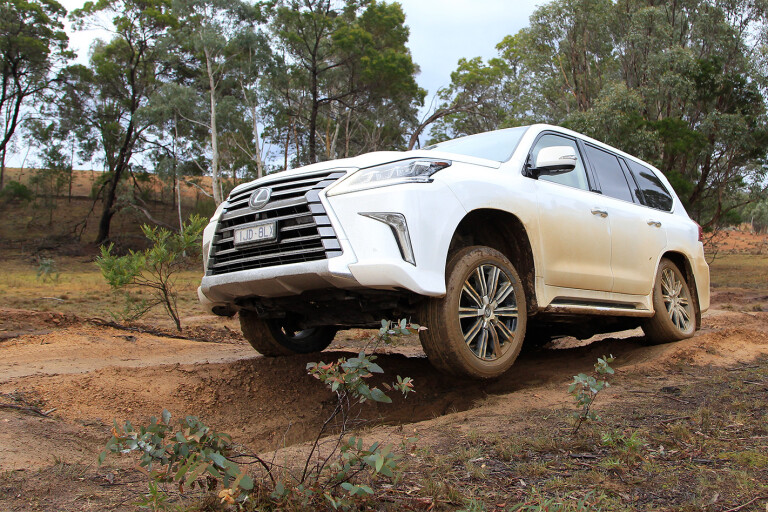
For what may be perceived as a gimmick, the Wide View Front and Side Monitor system’s four cameras are brilliant on tight tracks where obstacles are obscured from the driver’s seat. A slight bugbear is the MTS is convoluted in use, requiring more than a few steps to get the right mode selected. The 21-inch tyres are slightly more sensible than those on the QX80, but if we were considering this vehicle for touring duties we’d opt for the standard 20-inch wheels, as there are more off-road-biased tyre options in this size.
For an all-independent-suspension vehicle with a long wheelbase, less ground clearance and not much wheel travel, the QX80 is a surprise package off-road. The clever traction control system works brilliantly to keep the Infiniti moving forward, even when wheels are high off the ground; you rarely need to utilise the manually-activated rear locking differential. Again, as with the LX570, outward vision is not a strong point for the QX80 when off-road – and it is wider and longer – but its slab-sided exterior panels offer a more accurate perception of where the vehicle extremities are, allowing you to squeeze through narrow sections of track. A negative with the QX80 is the road-biased 22-inch tyres, as rubber in this size is a scarcity outside city limits.
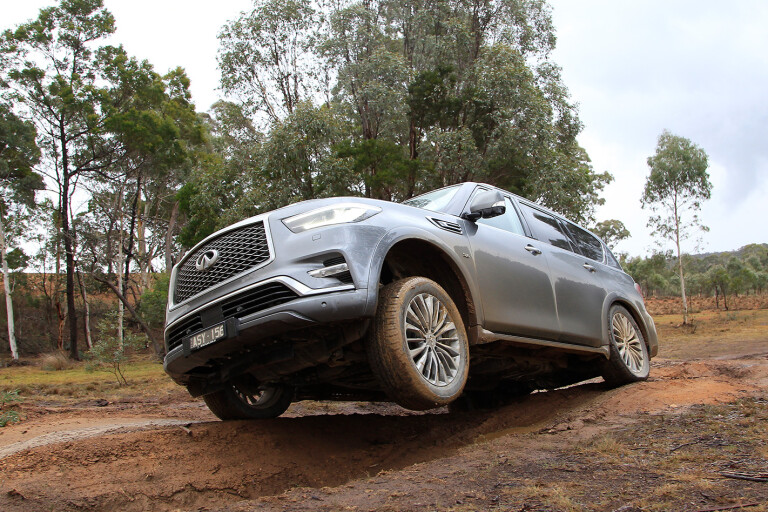
In terms of towing, both vehicles are well sorted thanks to their 3500kg braked towing capacities. In terms of off-road touring range, the LX570’s larger fuel tank will be a boon.
WINNER: Lexus LX570
WARRANTY AND SERVICING
THE Lexus LX570 comes with a four-year/100,000km warranty, with the six-month/10,000km service complimentary. It has free roadside assist for four years. The Infiniti QX80 has a four-year/100,000km warranty and four years roadside assistance.
WINNER: Tie
VERDICT
THESE two wagons are at the top of the tree when it comes to seriously capable off-road vehicles that combine luxury, comfort and performance with the latest in driving technology and safety. The appeal is their versatility; whether you’re trundling around town, dropping the kids off at school, towing a boat or caravan, or heading off-road for a camping trip, both of these will do so with ease.
The argument against them is the slightly frightening fuel consumption from their V8 petrol engines, but this is probably a non-issue for the cashed-up buyer. The LX570 offsets that consumption fear slightly with its much larger fuel tank, but you pay a considerable amount more for the privilege – the money saved buying the Infiniti pays for a hell of a lot of fuel.
You can’t really go wrong with either of these big wagons. The LX570 is the classic all-rounder, albeit one that is slightly compromised on-road. It turns this around off-road, and it has the advantage of a more appropriately-sized fuel tank, but it is starting to show its age in terms of the overall design (the Land Cruiser 200 Series was launched in 2007). Offsetting this, however, is the more comfortable ride, excellent build quality, and sterling reputation for reliability it garners from Toyota.
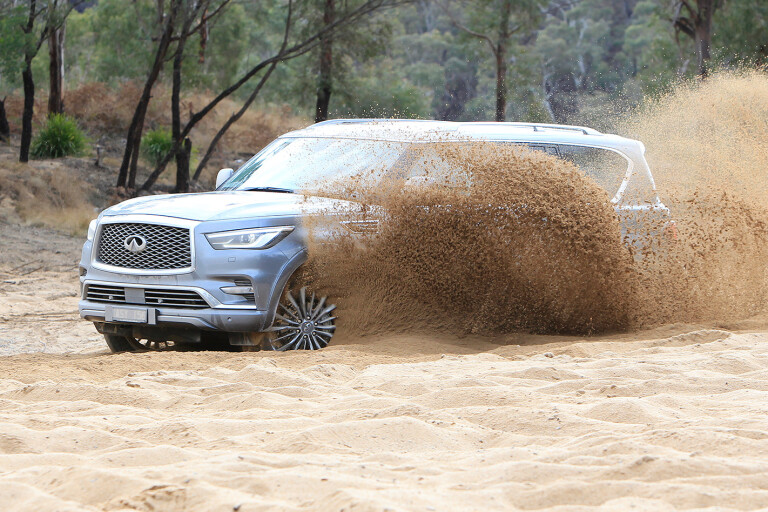
The Infiniti QX80’s more sporty on-road handling and performance, plus its impressive off-road capability, all appeal, but it is the significantly lower purchase price (with no sacrifice in terms of tech or spec levels), the larger interior and more cargo space that sees the Infiniti squeak across the line.

COMMENTS